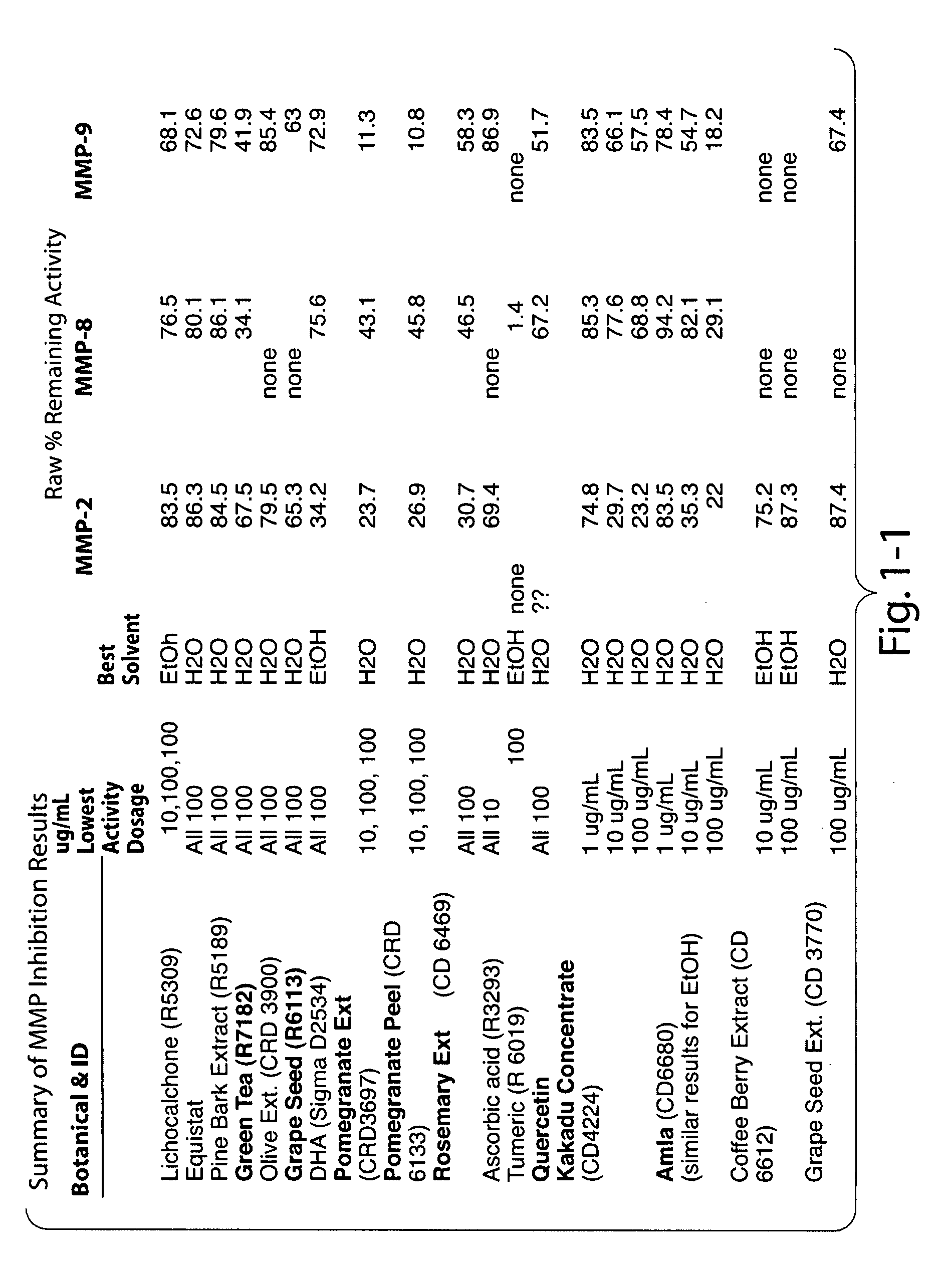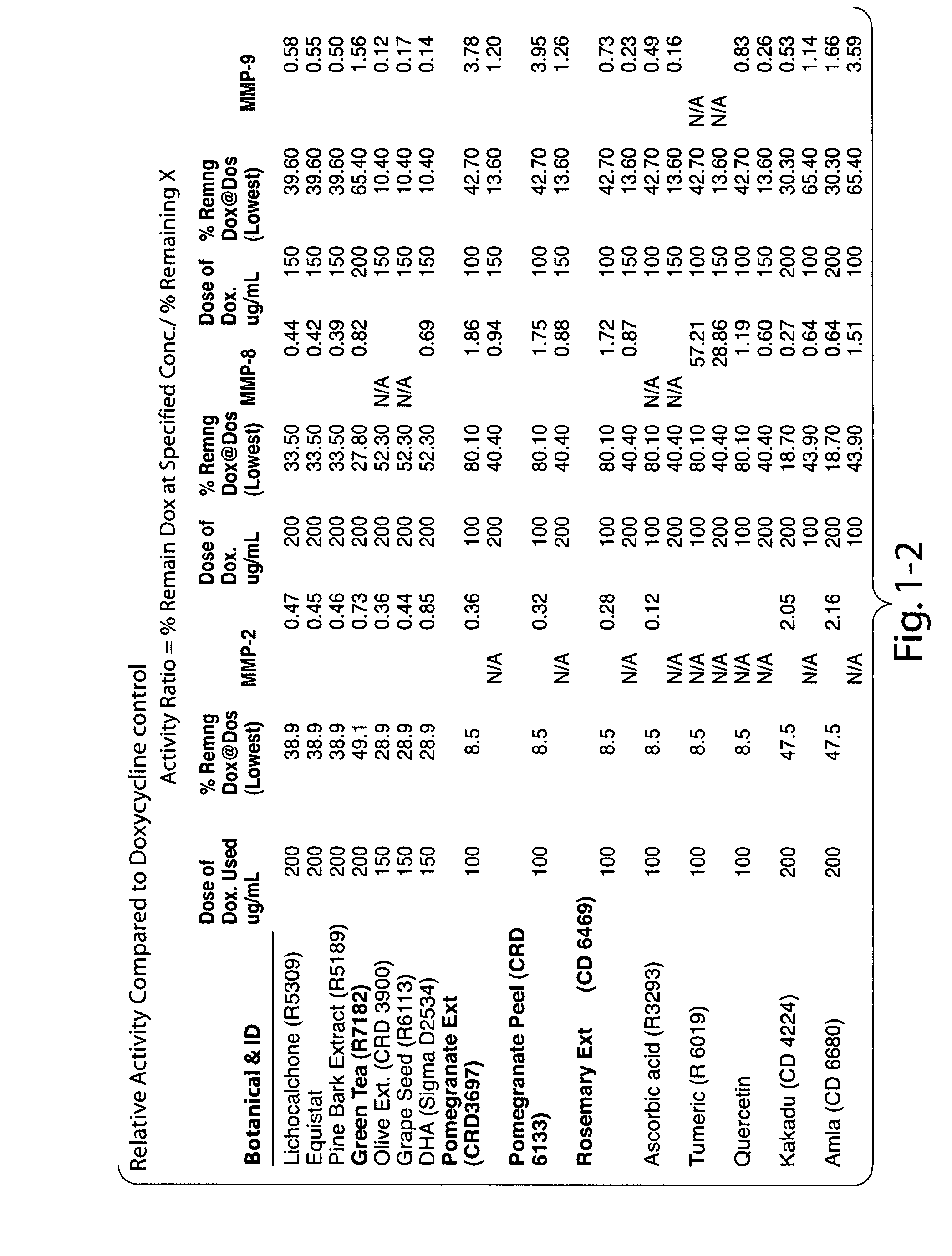Food Compositions and Methods of Treating Periodontal Disease
a technology of food compositions and periodontal disease, applied in the direction of biocide, drug compositions, plant/algae/fungi/lichens ingredients, etc., can solve the problems of tooth loss, minor symptoms, bad breath and bleeding gums
- Summary
- Abstract
- Description
- Claims
- Application Information
AI Technical Summary
Benefits of technology
Problems solved by technology
Method used
Image
Examples
example 1
In Vitro Identification of Natural MMP Inhibitors
[0069] In excess of 80 botanical extracts (BE), were screened in vitro for inhibition against MMP-2, 8, & 9 proteolytic activity. Individual calorimetric assay kits (BIOMOL) were used according to the manufacturer's instructions to measure the proteolytic activity of MMP's-2, 8, and 9 in the presence or absence of individual extracts. The known MMP-inhibitor, Doxycycline was used as an internal standard for comparison of inhibiting activity.
[0070] The results of these studies are shown in FIG. 1. Of the compound screened three are strong lead types and three are moderate lead types (potential secondary or blend ingredients), all of which showed inhibiting activity in excess of Doxycycline for one or more MMP's tested. (See Table 1)
TABLE 1Inhib. Relative to Doxy.(Fold = % inhib X / %inhib DoxBEMMP-2 or 9MMP-8Strong Leads:A) Pomegranate ext.3.781.86B) Pomegranate Peel Ext.3.951.75C) Amla Ext.3.591.51D) Rosemary Extract0.731.72Moderate...
example 2
Interference Studies
[0073] Individual calorimetric assay kits (BIOMOL) were used according to the manufacturer's instructions to measure the proteolytic activity of MMP's-2, 8, and 9 in the presence or absence of individual extracts and define mixtures of extracts. The known MMP-inhibitor, Doxycycline was used as an internal standard for comparison of inhibiting activity.
[0074] The following final concentrations of individual ingredients are combined (along with additional confirmatory test of the “neat” ingredients). Again all tests include a “gold standard” positive control (Doxycycline). The purpose of this interference testing is to see whether combined ingredients result in different levels of inhibition for all three MMP's (2, 8, 9) than found for individual ingredients. All samples are dissolved or extracted in water where practical and otherwise specified.
Series 1.Pomegranate (P) @ 10P10 + Am10Amla (Am)@ 10 μg / mlμg / mlP @ 100 μg / mlP10 + Am100Am @ 100 μg / mlP100 + Am100P100...
example 3
Evaluation or Rosehips for IL-1 Inhibitory Activity
[0085] The chosen ingredient for the inhibition of IL-1, Rosehips was shown to have an IC50 of <1.0 ug / mL in a cell-based in vitro assay screen. This ingredient was further tested and found active in clinical trials measuring subject peripheral blood monocyte IL-1 gene activity. This was not unexpected, since prior small studies in the literature found this extract effective against pain in knee osteoarthritis, and a separate study showed it could significantly lower CRP levels. This is the ingredient, which has been tested in our in vitro assays for interference against MMP inhibition.
PUM
 Login to View More
Login to View More Abstract
Description
Claims
Application Information
 Login to View More
Login to View More - R&D
- Intellectual Property
- Life Sciences
- Materials
- Tech Scout
- Unparalleled Data Quality
- Higher Quality Content
- 60% Fewer Hallucinations
Browse by: Latest US Patents, China's latest patents, Technical Efficacy Thesaurus, Application Domain, Technology Topic, Popular Technical Reports.
© 2025 PatSnap. All rights reserved.Legal|Privacy policy|Modern Slavery Act Transparency Statement|Sitemap|About US| Contact US: help@patsnap.com



